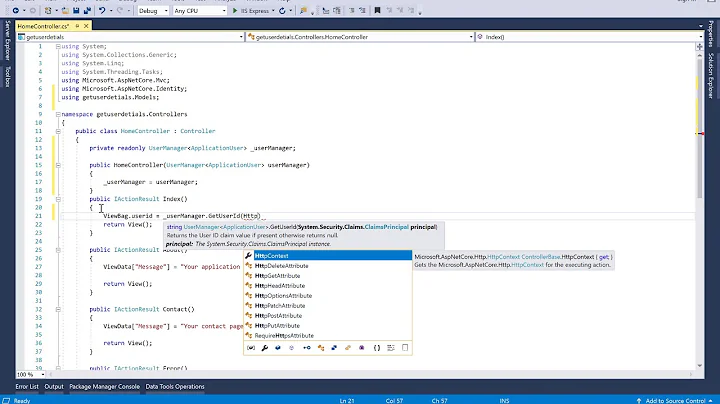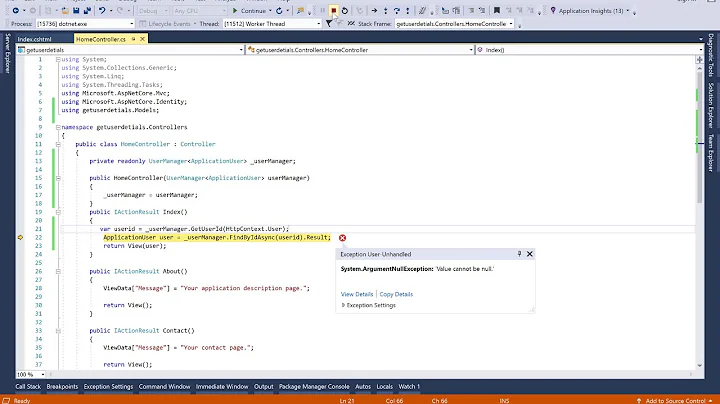How to get the current user in ASP.NET MVC
Solution 1
If you need to get the user from within the controller, use the User property of Controller. If you need it from the view, I would populate what you specifically need in the ViewData, or you could just call User as I think it's a property of ViewPage.
Solution 2
I found that User works, that is, User.Identity.Name or User.IsInRole("Administrator").
Solution 3
Try HttpContext.Current.User.
Public Shared Property Current() As System.Web.HttpContext
Member of System.Web.HttpContextSummary:
Gets or sets the System.Web.HttpContext object for the current HTTP request.Return Values:
The System.Web.HttpContext for the current HTTP request
Solution 4
You can get the name of the user in ASP.NET MVC4 like this:
System.Web.HttpContext.Current.User.Identity.Name
Solution 5
I realize this is really old, but I'm just getting started with ASP.NET MVC, so I thought I'd stick my two cents in:
Request.IsAuthenticatedtells you if the user is authenticated.Page.User.Identitygives you the identity of the logged-in user.
Related videos on Youtube
Serhat Ozgel
Software developer and consultant. Areas of expertise: Web application and api development, software development, cloud architecture, mobile application backend development, e-commerce software development and integration.
Updated on July 08, 2022Comments
-
 Serhat Ozgel almost 2 years
Serhat Ozgel almost 2 yearsIn a forms model, I used to get the current logged-in user by:
Page.CurrentUserHow do I get the current user inside a controller class in ASP.NET MVC?
-
 Serhat Ozgel over 15 yearsWhere does this Membership class come from? IntelliSense does not recognize it by default.
Serhat Ozgel over 15 yearsWhere does this Membership class come from? IntelliSense does not recognize it by default. -
 Serhat Ozgel over 15 yearsApparently HttpContext does not have a property named "Current".
Serhat Ozgel over 15 yearsApparently HttpContext does not have a property named "Current". -
Sean over 15 yearsThe System.Web.Security namespace. I'm not positive this is useful in MVC but I use it with the login controls for Web Forms.
-
Jeff Sheldon over 15 yearsI believe you two are talking about two different things. System.Web.HttpContext and the static property: System.Web.Mvc.Controller.HttpContext (Which does not have a "Current" property.
-
 mawaldne over 14 years"or you could just call User as I think it's a property of ViewPage" - So do you mean use Page.user when you're in the view?
mawaldne over 14 years"or you could just call User as I think it's a property of ViewPage" - So do you mean use Page.user when you're in the view? -
 Wagner Danda da Silva Filho almost 14 yearsThat worked on a non-MVC environment, just what I needed. Thanks! :)
Wagner Danda da Silva Filho almost 14 yearsThat worked on a non-MVC environment, just what I needed. Thanks! :) -
 jamiebarrow over 13 yearsIt's useful in any ASP.NET application that uses the Membership providers.
jamiebarrow over 13 yearsIt's useful in any ASP.NET application that uses the Membership providers. -
 Mike Cole over 11 yearsThis will actually make a database request. HttpContext.Current.User doesn't.
Mike Cole over 11 yearsThis will actually make a database request. HttpContext.Current.User doesn't. -
Jed Grant almost 11 yearsUnfortunately this doesn't seem to work anymore in MVC 5. Not sure why =/
-
Sean almost 10 yearsYes, you can use it like, "Hi, @User.Identity.Name!" in the cshtml.
-
 Paul over 9 yearsJust to add to this, if you're working in a class outside of a form you'll either need to
Paul over 9 yearsJust to add to this, if you're working in a class outside of a form you'll either need toImports System.Weband further qualify with withHttpContext.Current.User.Identity.Name, or directly qualify using the full syntax:System.Web.HttpContext.Current.User.Identity.Name -
 ryanyuyu almost 9 yearsWhile this code may answer the question, it would be better to include some context, explain how it works, and describe when to use it. Code-only answers are not useful in the long run.
ryanyuyu almost 9 yearsWhile this code may answer the question, it would be better to include some context, explain how it works, and describe when to use it. Code-only answers are not useful in the long run. -
 GrandMasterFlush almost 9 yearsSystem.Security.Principal.WindowsIdentity.GetCurrent().Name returns the current user logged into Windows, the OP is asking for the user currently logged into the web site.
GrandMasterFlush almost 9 yearsSystem.Security.Principal.WindowsIdentity.GetCurrent().Name returns the current user logged into Windows, the OP is asking for the user currently logged into the web site. -
Simple Sandman about 8 yearsIf you are getting this error
'System.Web.HttpContextBase' does not contain a definition for 'Current' and no extension method 'Current' accepting a first argument of type 'System.Web.HttpContextBase' could be found, I would suggest making an absolute call like this,System.Web.HttpContext.Current.User.Identity.Name. -
 usefulBee almost 8 yearsThis works only inside a Controller; or if your ViewModel inherits from Controller
usefulBee almost 8 yearsThis works only inside a Controller; or if your ViewModel inherits from Controller -
 usefulBee almost 8 yearsWorks inside a Controller and if using a ViewModel either inherit from Controller or follow Paul's suggestion.
usefulBee almost 8 yearsWorks inside a Controller and if using a ViewModel either inherit from Controller or follow Paul's suggestion. -
PineCone almost 8 yearsOnly
System.Security.Principal.WindowsIdentity.GetCurrent().Nameworks inMVC 5. However that pulls up the domain name with the username. i.e. domain\username -
Beau D'Amore over 7 yearsI do not believe so, as this is explicitly using your Active Directory user credentials. Why would you have 'Forms' if you desire your users to be authenticated via AD?
-
 Patee Gutee over 7 yearsIn our organization, there are locations where we have a couple of workstations that are shared by several "field" personnel. Because of that, we are required to add the login page to our intranet web applications.
Patee Gutee over 7 yearsIn our organization, there are locations where we have a couple of workstations that are shared by several "field" personnel. Because of that, we are required to add the login page to our intranet web applications. -
Beau D'Amore over 7 yearsas a workaround: you could have two copies of this app running, one in 'Forms' mode with it's own identity tables or you can mix both in one app, but it's trickier. A quick google revealed this: stackoverflow.com/questions/2250921/…
-
Beau D'Amore over 7 years<identity impersonate="true" /> might need to change if mixing
-
 Gilberto B. Terra Jr. over 7 yearsThis method return a System.Guid
Gilberto B. Terra Jr. over 7 yearsThis method return a System.Guid -
Samra almost 7 yearsUser.Identity.Name is an instance of System.Security.Principal.IPrincipal which does not have an id property... Is this User different from User.Identity.GetUserId 's User object
-
 Jason Geiger almost 5 yearsThis gets you the username of the AppPool that the application is running as.
Jason Geiger almost 5 yearsThis gets you the username of the AppPool that the application is running as. -
rickyProgrammer over 3 yearshi @rajbaral This worked for me, what if i want to extract the other information from the current user from the db, example address field.
-
 Raj Baral over 3 years@rickyProgrammer you need to write a method to get UserProfile from your AD using that
Raj Baral over 3 years@rickyProgrammer you need to write a method to get UserProfile from your AD using thatuserName -
Lemiarty about 2 yearsvar userName = System.Security.Principal.WindowsIdentity.GetCurrent().Name; This is just straight up incorrect information. This call will get you the identity of the Application Pool and not of the web user.







